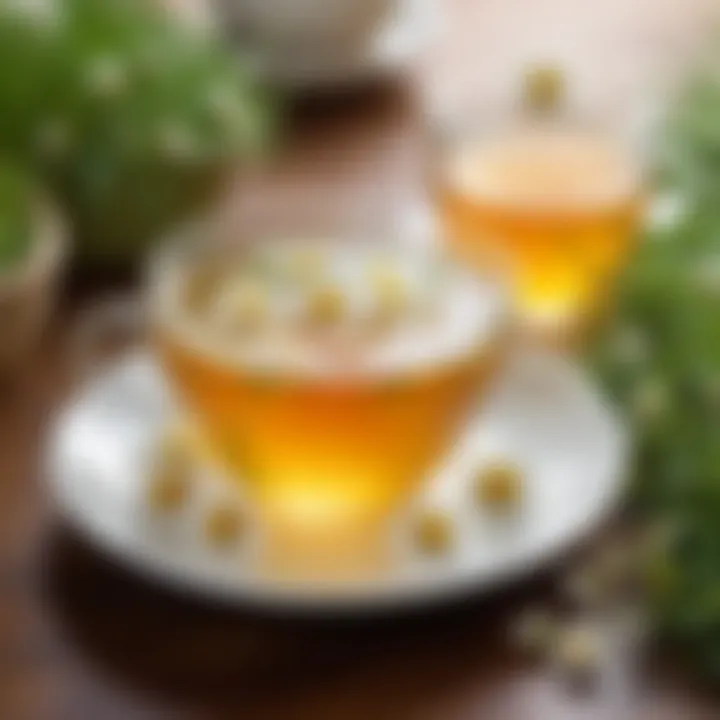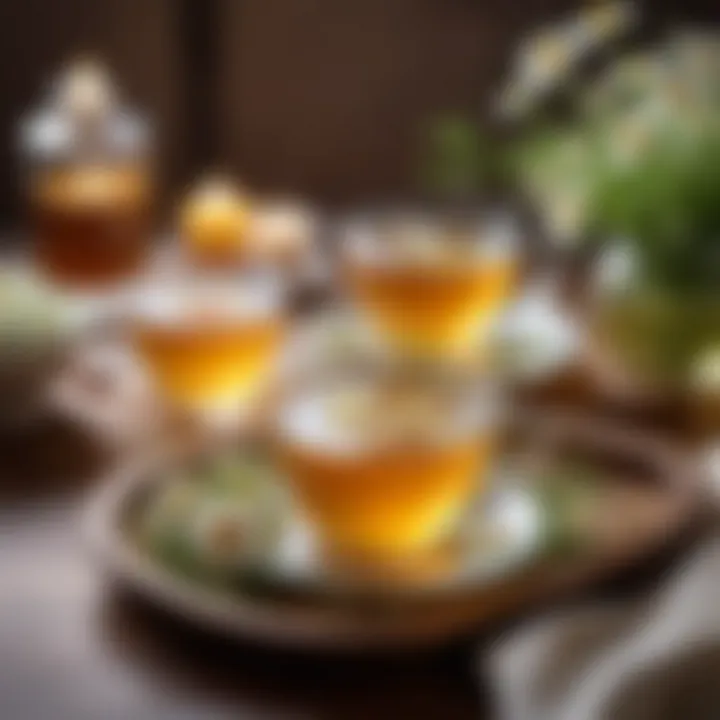Optimal Timing for Enjoying Chamomile Tea


Intro
Chamomile tea has been cherished for centuries, not just for its appealing taste but also for a range of health benefits. When looking at the best times to sip on this renowned herbal infusion, it becomes clear that timing can be just as crucial as the tea itself. The anticipated calming effects, in addition to the physiological advantages, transform chamomile tea into more than just a warm beverage—it’s a companion in improving both mental and physical wellness.
In this discussion, we will explore the optimal moments for enjoying chamomile tea, supported by insights into its biological and psychological impacts. Different scenarios where chamomile can be particularly effective will be examined. By incorporating this soothing drink into your daily routine at the right times, you could enrich not just your relaxation practices but also enhance your overall well-being.
With settings ranging from stressful workdays to tranquil evenings, the appropriate consumption of chamomile tea can be life-changing. Burke once said, "The root of all happiness is good health," and perhaps chamomile tea is one of the delightful ingredients in that recipe. Let’s jump into the nitty-gritty of this herbal marvel.
Understanding Chamomile Tea
In the realm of herbal teas, chamomile stands tall, somewhat like a warm, cozy blanket on a cold night. When we talk about understanding chamomile tea, we’re diving deep into its roots, benefits, and the little nuances that make it such a beloved choice for so many. Its calming qualities have made it a staple in kitchens around the world, yet so many of us might miss out on its fascinating backstory and its various manifestations.
Origins and Historical Significance
Chamomile boasts a rich history that stretches back thousands of years. The ancient Egyptians were among the first to utilize this flowering herb, often paying homage to it for its healing properties. They revered chamomile as a gift from the Sun God, and they utilized it in their rituals and medicines. Fast forward a few centuries, and the Greeks, including Hippocrates, began using it for its therapeutic benefits, seeing it as a remedy for various ailments ranging from fevers to digestive issues.
As history would have it, chamomile has been a significant player in traditional medicine throughout Europe as well. It’s no surprise then that today, it thrives in gardens and homes alike, with many still holding on to its age-old virtues.
Types of Chamomile
Not all chamomile teas are cut from the same cloth. Understanding the two predominant types gives us insight into their differences and why one may be favored over the other.
German Chamomile
German chamomile often takes the spotlight in the tea world. Its flowers are smaller and somewhat more potent than its Roman counterpart. The essential oils found in German chamomile offer a robust flavor profile, making it a more popular choice among tea aficionados. Additionally, it’s known for its higher concentration of antioxidants, which contributes to its anti-inflammatory and calming effects. Many folks choose it not just for its taste but also for its beneficial effects that can ease anxiety and promote better sleep.
Roman Chamomile
Roman chamomile, on the other hand, has a sweeter and milder flavor. Its vibrant, daisy-like flowers are often a choice for those looking to create soothing infusions without a strong herbal taste. What makes Roman chamomile particularly interesting is its historical use in stress relief and digestion improvement. While it might not pack the same punch as German chamomile, its gentleness can be an advantage for those sensitive to stronger flavors.
Nutritional Profile and Active Compounds
The nutritional benefits of chamomile tea go beyond just its soothing capabilities. Packed with phytonutrients, antioxidants, and a host of flavonoids, chamomile serves up a plate full of health benefits. Regular consumption may help in reducing inflammation, bolstering the immune system, and even enhancing mood. Its active compounds, such as apigenin, play a significant role in promoting relaxation and sleep induction.
"Chamomile isn't just a beverage; it’s a treasure trove of health benefits waiting to be unlocked."
In summary, understanding chamomile tea — its origins, types, and nutritional profile — sets the stage for further exploration into its myriad benefits. The journey of this humble flower from ancient temples to our modern kitchens highlights its enduring appeal and relevance in today's wellness conversations.
Health Benefits of Chamomile Tea
Chamomile tea is more than just a soothing beverage; it stands out for its wide array of health benefits. This calming drink has been cherished for centuries across different cultures, and modern science is now beginning to affirm many of the claims surrounding its healing properties. It plays a pivotal role in promoting mental and physical well-being.
Calming Effects and Stress Relief
One of the primary attractions of chamomile tea is its ability to alleviate stress and provide a sense of calm. The natural compounds found in chamomile, especially apigenin, bind to certain receptors in the brain, producing a mild sedative effect. This characteristic makes it particularly appealing for those day-to-day stresses, like job pressures or family obligations.
Many folks find that a warm cup of chamomile tea can set the tone for a more tranquil evening, easing the tensions that build up during a busy day. It’s often recommended to consume this tea during moments of high tension or when facing overwhelming tasks. The ritual itself—preparing and savoring the tea—becomes a calming practice, allowing individuals to carve out a moment for themselves amidst a chaotic day.
Aid for Sleep Disorders
Insomnia
Insomnia can feel like a relentless thief, robbing people of much-needed rest. When dealing with insomnia, many seek out chamomile as a natural solution. Research suggests that drinking chamomile tea may reduce the symptoms of insomnia by inducing sleepiness and improving overall sleep duration.
The key characteristic of this blend is its ease of access—whether in a tea bag or loose leaf, chamomile is simple to include as part of a nightly routine. A unique feature of using chamomile for managing insomnia is that it isn't just a one-size-fits-all solution; some individuals find that integrating it into their evening rituals helps signal the body that it’s time to wind down. However, it’s important to recognize that results can vary from person to person, and while some may find immediate benefits, others might not notice significant changes right away.
Sleep Quality Enhancement


Beyond just helping people doze off, chamomile tea is also known for enhancing overall sleep quality. Many users report feeling more refreshed after a night of chamomile-induced slumber. The effects of chamomile can extend to deeper sleep phases, allowing individuals to experience restorative rest.
This enhancement makes it a popular choice for people who frequently wake up during the night or struggle to remain asleep until morning. The unique feature of focusing on sleep quality highlights the nuanced benefits of chamomile, suggesting that it could play a role in overall health when incorporated regularly, potentially improving mood, cognitive functionality, and energy levels during the day.
Digestive Health Benefits
Chamomile tea offers noteworthy digestive health benefits, making it a valuable addition to one's daily routine. Its anti-inflammatory and antispasmodic properties can soothe the digestive tract, alleviating issues like bloating or gas. By promoting digestion, chamomile may also help to ease symptoms related to gastrointestinal disorders.
Drinking chamomile tea can act as a gentle remedy for nausea or an upset stomach, providing comfort during situations that might otherwise feel distressing. The warmth of the tea can aid digestion and promote a sense of overall wellness, indicating why it has been utilized traditionally after meals to support digestive health.
Taking it all into account, chamomile tea appears to be a versatile ally for promoting calmness, improving sleep patterns, and supporting digestive health. With its myriad benefits, knowing the right times to enjoy this herbal infusion can further enhance its positive impacts.
Optimal Timing for Consumption
Understanding when to drink chamomile tea is crucial for maximizing its benefits. The timing can influence how effectively it promotes relaxation, aids sleep, or enhances digestion. Each phase of the day holds a different potential for chamomile tea, matched to the natural rhythms of our bodies. This section aims to explore these timeframes, allowing readers to make informed choices about when to integrate chamomile tea into their daily routines. By adjusting consumption time, one can optimize the effects of this soothing herbal blend while complementing various lifestyle needs and personal health goals.
Morning Rituals
Imagine starting your day with a warm cup of chamomile tea. Morning rituals often set the tone for the day, and incorporating chamomile may provide a gentle, calming influence to ease into the day's hustle. While many individuals reach for a robust coffee, chamomile tea can bring forth a feeling of tranquility that helps you prepare mentally for the challenges ahead.
Drinking chamomile in the morning can also support digestion, which is essential after a night of fasting. Its mild nature won’t weigh you down but rather awaken the senses gently. It might just be the zesty addition needed to counterbalance a busy, brisk morning.
Afternoon Relaxation
As the day unfolds, stress might begin to creep in. During this time—a midday pause, if you will—chamomile tea can serve as a wonderful companion. It can help you hit the brakes, providing a moment to gather your thoughts and recharge. That 3 PM slump often signals a need for a pick-me-up, and chamomile might just fit the bill beautifully, especially when consumed in combination with a light snack.
Incorporating chamomile tea into your afternoon can be beneficial for digestion as well. It can help settle that post-lunch fullness, promoting comfort and wellness during a sometimes hectic workday. Customizing this ritual according to personal preferences—perhaps with a splash of honey or lemon—can elevate the experience.
Evening Wind Down
At day’s end, chamomile tea transforms into a soothing elixir, ideal for its sleep-enhancing properties. Having a cup as part of your nightly routine can signal to your body that it’s time to unwind. This is particularly significant for those who struggle with insomnia or racing thoughts that come with the day’s reflections.
Consistency is key; developing a habit of drinking chamomile tea each evening can train the body to transition into relaxation mode. Whether curled up with a book or enjoying quiet moments of mindfulness, this calming beverage can become a favorite staple in your wind-down ritual.
"Chamomile tea is not just a drink; it’s a step toward a peaceful mind and relaxed body."
Many people have touted the merits of chamomile both psychologically and physically, making it an excellent choice for night owls or anyone needing a reprieve. It provides an opportunity to escape the digital noise, allowing you to indulge in a few moments of you-time before peaceful sleep.
Individual Factors Influencing Consumption Timing
Understanding how various individual factors affect the timing of chamomile tea consumption is crucial for optimizing its benefits. Each person's lifestyle, health conditions, and personal preferences can significantly dictate how and when chamomile tea can be integrated into daily life. Tailoring the consumption timing to suit one’s unique circumstances leads to more effective use of this herbal remedy, enhancing its calming and health-promoting properties.
Lifestyle Considerations
Lifestyle plays a significant role in determining the best moments to enjoy chamomile tea. For instance, a hectic job might lead someone to seek moments of calm amidst chaos. Drinking chamomile tea during break times can aid in stress relief. Individuals who work in stressful environments should consider keeping chamomile tea handy; it may serve as a small ritual to unwind.
Moreover, lifestyle factors such as typical work hours, family commitments, and social engagements can influence when to drink chamomile tea. For example, someone juggling evening classes or late work shifts may benefit from an afternoon cup to set a tranquil tone for the evening ahead. Finding a balance is essential; integrating chamomile tea at moments when it feels like the weight of the world is on one’s shoulders perhaps allows the mind to grasp its tranquil essence fully.
Health Conditions
Health conditions can considerably dictate the need and timing for chamomile tea consumption. Individuals experiencing digestive issues might find it helpful to drink chamomile tea following meals, as it aids digestion and soothes discomfort. On the other hand, people dealing with insomnia may need to steep a cup right before bedtime to help their bodies relax and signal bedtime.
It's crucial to consider any existing health issues, including allergies. Chamomile could interact with certain conditions or medications, so it's always wise to consult a healthcare provider before making it a routine. But, in general, being mindful of health conditions can help in leveraging the benefits of chamomile tea successfully.
Personal Preferences
Personal taste plays a substantial role in how and when chamomile tea fits into one's routine. Some people might prefer their chamomile tea hot, savoring it during colder evenings, while others may enjoy it iced on warmer days. Preferences also extend to flavorings—adding honey, lemon, or various spices can enhance the experience, making the tea more appealing at different times.
Furthermore, establishing a personal tea ritual can elevate the coziness associated with chamomile tea. Whether setting aside a few minutes in the morning to sip it with breakfast or unwinding with a cup in the evening while reading, the ritual itself can become a cherished routine. After all, it’s the tune of one’s own drum that makes a perfect melody—being attuned to personal preferences leads to a more enjoyable and beneficial experience.


As you engage with chamomile tea, reflect on your lifestyle, health conditions, and personal preferences. Tailoring your tea times can lead to a more enriched experience, amplifying its calming benefits.
When individuals consider these factors, they can optimize the timing of chamomile tea consumption, allowing it to seamlessly integrate into their daily lives.
Methods of Preparation
Chamomile tea is celebrated not only for its calming effects but also for its versatility in preparation. How tea is made can significantly influence its flavor, aroma, and health benefits. In this section, we will explore both traditional brewing techniques and modern infusion methods, showcasing the insights crucial for anyone looking to elevate their chamomile tea experience.
Traditional Brewing Techniques
Brewing chamomile tea the traditional way often involves using flowers, dried or fresh, which are steeped in hot water. This method is simple yet effective; it preserves the natural oils and flavors found in the blossoms. One key aspect here is the temperature of the water. For optimal extraction, water that is too hot can destroy delicate compounds, while cooler water might not extract enough flavor. Thus, a good rule of thumb is to heat the water to just below boiling point – around 200°F (93°C) works well.
When using traditional brewing, timing is crucial. Steeping for about five to ten minutes allows the natural goodness to seep in without becoming too bitter. Remember, patience is a virtue!
It’s also worth noting that traditional methods allow tea enthusiasts to experiment with different steeping times and ratios, thus tailoring the flavor to personal preference. Not only are you extracting health benefits, but you're also engaging in a mindful practice, which can be quite rewarding.
Modern Approaches to Infusion
With the rise of convenience, modern approaches to chamomile tea preparation have gained significant traction. Contemporary methods often involve the use of tea bags or cold brew techniques, each with its distinct characteristics and outcomes.
Tea Bags vs. Loose Leaf
When comparing tea bags with loose leaf, convenience holds a strong card. Tea bags offer quick brewing and minimal cleanup, appealing to those with a hectic lifestyle. However, the trade-off often comes with reduced flavor complexity and aroma, as bagged tea tends to use lower quality leaves packed tightly.
On the flip side, loose leaf chamomile tea generally provides a more robust flavor profile and full-bodied experience. The larger pieces of flowers allow for better infusion and extraction of beneficial compounds. Hence, if time permits, going loose leaf can be the preferable choice. However, if you're on the go, a high-quality tea bag can suffice and still deliver some health benefits.
Cold Brew Methods
An alternative that has gained popularity is cold brewing. This method involves steeping chamomile tea in cold or room-temperature water for several hours, usually overnight. Cold brew results in a smoother, less tannic tea, making it a refreshing choice, particularly during warmer months.
Using cold brew also preserves the delicate floral notes and minimizes bitterness. While this method takes longer and requires pre-planning, the convenience of having a ready-to-drink tea can be a game changer. Cold brewing chamomile allows users to enjoy a different tasting experience while still reaping all the tea's health benefits. However, keep in mind the steeping time; a minimum of 6 hours is recommended for an adequate flavor extraction.
"Good things come to those who wait, especially when it comes to brewing chamomile!"
Understanding these preparation methods enhances the chamomile tea experience, making it a versatile and beneficial addition to your daily routine. Each method serves its purpose, so consider what fits best into your lifestyle and preferences.
As this section illustrates, crafting the perfect cup of chamomile tea isn't just about throwing some flowers in hot water; it's an art that, when mastered, can significantly enhance both taste and well-being.
Potential Side Effects and Precautions
When diving into the world of chamomile tea, it’s essential to be aware of possible side effects and precautions that come along with this seemingly tranquil beverage. While chamomile boasts a plethora of health benefits, it’s not entirely devoid of risks. Addressing these concerns not only enhances one’s knowledge but also promotes responsible consumption, aiding individuals in maximizing the positive aspects while minimizing potential adverse reactions. Understanding these elements creates a more holistic relationship with chamomile tea, ultimately enhancing one's wellness routine.
Allergic Reactions
Chamomile is part of the Asteraceae family, which also includes other known allergens, such as ragweed. For individuals allergic to these plants, chamomile could potentially trigger reactions ranging from mild symptoms like skin rash or hives to more severe responses such as anaphylaxis. This is particularly crucial to consider for those who have a history of plant allergies.
It’s prudent to test the waters by consuming a small amount of chamomile tea first, before fully integrating it into a daily regimen. Symptoms to watch out for may include:
- Itchy or swollen throat
- Skin reactions, like redness or rash
- Gastrointestinal distress
- Difficulty breathing in severe cases
Always consulting with a healthcare professional before adding chamomile tea into daily consumption is a smart bet, particularly if prior allergies are present.
Interactions with Medications
Another significant aspect of chamomile tea consumption is its potential to interact with various medications. Chamomile can possess sedative properties; thus, individuals under medication for anxiety, sleep disorders, or depression should tread carefully. Some drugs that might illicitly tango with chamomile include:
- Blood thinners like warfarin, which can heighten the risk of bleeding.
- Antidepressants, which may amplify sedative effects leading to excessive drowsiness.
- Nonsteroidal anti-inflammatory drugs (NSAIDs), that can potentially create a compounded effect on the liver.
- Anticoagulants and antiplatelets, as chamomile might enhance their effects, leading to unwanted bleeding.
Being upfront with health care providers about all supplements and teas consumed is vital for ensuring safety. It’s also ideal to consult them before steeping that first cup, particularly if already navigating complex medication regimens.


Always prioritize your health by researching and understanding what you put into your body. Chamomile tea can be a soothing ally, but it’s essential to know its boundaries.
Incorporating Chamomile Tea into Daily Life
Integrating chamomile tea into your daily routine brings a multitude of benefits that extend well beyond mere taste. For those seeking to enhance their overall well-being, making chamomile tea a staple can lead to noteworthy improvements in relaxation and sleep quality.
A common thread among holistic health practices is the emphasis on establishing consistency. By consuming chamomile tea during specific times of the day, you signal your body that it’s time to unwind or prepare for rest. This not only increases the tea’s effectiveness but also helps imbue your day with moments of mindfulness and calm. The beauty of chamomile lies in its versatility; whether it works as a gentle morning aide to center your thoughts or as an evening ritual to wind down, it can adjust seamlessly to your lifestyle.
Therefore, the exploration around how to best incorporate chamomile into your day is essential. It encompasses understanding when you might need a moment of respite and recognizing the unique effects of chamomile that align with various activities throughout your day.
Creating a Chamomile Routine
Establishing a chamomile routine requires a balance of preference and practicality. Consider setting aside time in the morning or evening, perhaps when you find the day’s pace too frenetic or your mind spinning like a top. Brewing yourself a cup can be more than just hydration; it becomes a ritual that cultivates tranquility.
Some ideas to consider when building your routine include:
- Choosing a specific time each day to enjoy your tea.
- Making it a personal moment—perhaps pairing it with a favorite reading material or just a moment of quietude.
- Experimenting with different methods of preparation to find what suits your taste and enhances the experience.
Creating this habit transforms chamomile tea into a reliable companion that enriches your day.
Complementary Practices
Meditation
In our fast-paced world, finding stillness can feel challenging. That’s where meditation can step in. When paired with chamomile tea, meditation offers a substantial commitment to calmness and clarity. The key characteristic of meditation as a complementary practice is its ability to anchor your thoughts.
Meditation is a popular choice because it requires little to no special preparation; you can engage in it anywhere and anytime. Simply sit down with your cup of chamomile, close your eyes, and focus on your breathing. This pairing creates an environment for reflection, ultimately leading to a clearer mind and reduced stress levels.
One unique feature of meditation is its adaptability. There’s no one-size-fits-all; you can study different techniques and see what nurtures your spirit, whether it’s guided imagery, breath work, or body scanning. The advantage this provides in the context of incorporating chamomile tea into your life is profound—it promotes a sense of harmony with the natural rhythms of your body and mind.
Mindfulness Techniques
Much like meditation, mindfulness techniques can serve as a gentle reminder to savor life’s moments. They encourage being present and appreciating small experiences, like sipping chamomile tea. The key characteristic of mindfulness is its focus on awareness; it helps draw our attention back to the here and now.
Mindfulness is especially beneficial in a world where distractions are abundant. When paired with chamomile tea, it encourages pausing—taking time to notice the flavors, aromas, and warmth of your drink. The act of mindful sipping can become a moment of gratitude, contributing to overall life satisfaction.
One unique aspect of mindfulness techniques is their broad application; they can be woven into daily activities. Whether you practice mindful walks, eating, or even breathing techniques, the rich effects remain a constant. The advantages are compelling—by intertwining mindfulness with your chamomile routine, you cultivate not only relaxation but an enriched appreciation for life.
"Small rituals, like enjoying chamomile tea, can bring great calm in the chaotic tapestry of the day."
In sum, incorporating chamomile tea into your daily life can be deeply transformative when paired with practices like meditation and mindfulness. By building these habits, you foster an atmosphere of peace that permeates multiple facets of your life, making it easier to navigate its ups and downs.
The End
In wrapping up our discussion on the consumption of chamomile tea, it’s crucial to undersc ore the multifaceted benefits that this calming beverage offers. Understanding when to imbibe chamomile tea can play a significant role in maximizing its health advantages and enhancing overall well-being.
From its soothing properties to its potential as a sleep aid, chamomile acts as a friendly companion in various life moments. It's not just about drinking tea; it's about mindful timing.
Summarizing Key Insights
Chamomile tea stands out for its ability to promote relaxation, with benefits that can be tailored to different times of the day. Here are the primary takeaways:
- Morning Rituals: Starting your day with chamomile provides a gentle awakening, easing you into your routine and offering a tranquil mindset.
- Afternoon Relaxation: A cup in the afternoon can combat midday stress and improve focus, providing that much-needed pause.
- Evening Wind Down: Perhaps most notable is its role in the evening, when a warm cup can signal your body that it’s time to rest, potentially improving sleep quality.
- Individual Factors: Everybody is unique; personal lifestyle and health considerations should guide individual tea-drinking habits.
Takeaway: Timing your chamomile consumption can enhance its calming effects, making it a versatile addition to your daily routines.
Encouragement for Personal Experimentation
Experimentation is a key theme when it comes to integrating chamomile tea into your life. I encourage you to play around with different times of the day. Notice how your body responds—whether it’s in the morning to kickstart a busy day, during that sluggish afternoon slump, or as a prelude to sleep.
Here are some ideas for personal experimentation:
- Keep a Tea Journal: Track when you drink your chamomile tea and how you feel thereafter. This can help identify patterns that work best for you.
- Mix it Up: Consider adding some other herbs to your chamomile. For example, a dab of honey or a splash of lemon can change the taste, but also the experience.
- Mindfulness Practice: Take a moment to savor each cup. Focus on how it feels to sip slowly and consider its heat and aroma. That simple mindfulness can amplify relaxation.
By integrating these practices into your routine, you can find your perfect timing with chamomile tea while enjoying its myriad benefits. There’s no one-size-fits-all approach here, and that’s the beauty of it. Curl up with a cup and discover your own rhythm.







